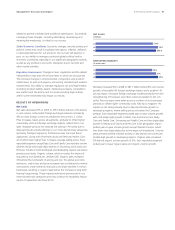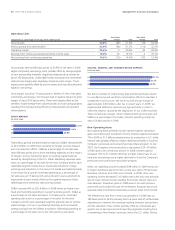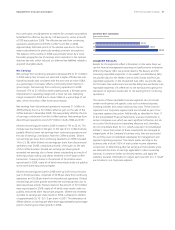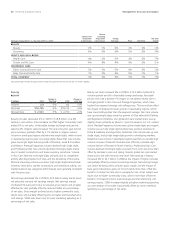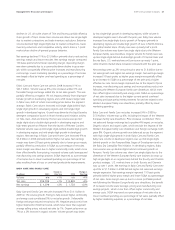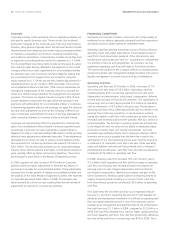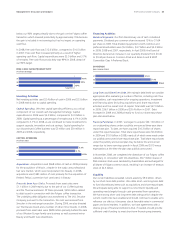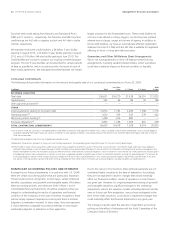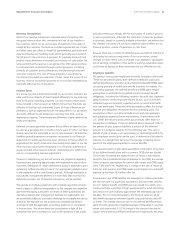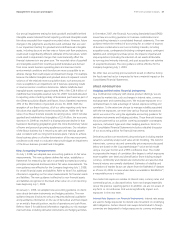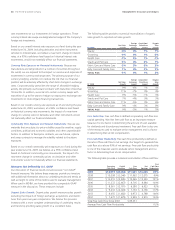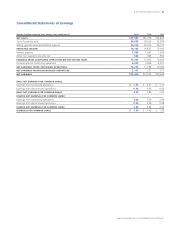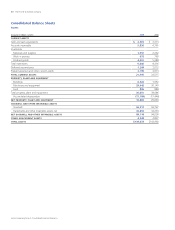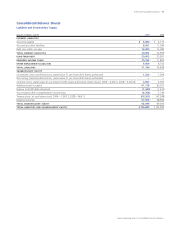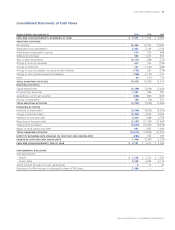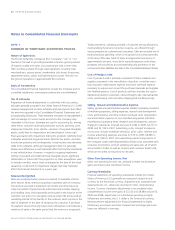Proctor and Gamble 2009 Annual Report Download - page 46
Download and view the complete annual report
Please find page 46 of the 2009 Proctor and Gamble annual report below. You can navigate through the pages in the report by either clicking on the pages listed below, or by using the keyword search tool below to find specific information within the annual report.
44 The Procter & Gamble Company Management’s Discussion and Analysis
Our short-term credit ratings from Moody’s and Standard & Poor’s
(S&P) are P-1 and A-1+, respectively. Our Moody’s and S&P long-term
credit ratings are Aa3 with a negative outlook and AA- with a stable
outlook, respectively.
We maintain three bank credit facilities: a $6billion 5-year facility
expiring in August 2012, a $3billion 5-year facility expiring in August
2012 and a $1.8billion 364-day facility expiring in June 2010. The
credit facilities are in place to support our ongoing commercial paper
program. The two 5-year facilities can be extended for certain periods
of time as specified in, and in accordance with, the terms of each of
these credit agreements. We anticipate that these facilities will remain
largely undrawn for the foreseeable future. These credit facilities do
not have cross-default or ratings triggers, nor do they have material
adverse events clauses, except at the time of signing. In addition to
these credit facilities, we have an automatically effective registration
statement on Form S-3 filed with the SEC that is available for registered
offerings of short- or long-term debt securities.
Guarantees and Other Off-Balance Sheet Arrangements
We do not have guarantees or other off-balance sheet financing
arrangements, including variable interest entities, which we believe
could have a material impact on financial condition or liquidity.
Contractual Commitments
The following table provides information on the amount and payable date of our contractual commitments as of June 30, 2009.
($ millions) Total
Less Than
1 Year 1– 3 Years 3– 5 Years
After
5 Years
RECORDED LIABILITIES
Total debt $36,631 $16,270 $1,438 $6,091 $12,832
Capital leases 392 46 84 76 186
Unrecognized tax benefit (1)
—————
OTHER
Interest payments relating to long-term debt 12,616 1,183 2,469 1,788 7,176
Operating leases(2) 1,620 305 495 378 442
Minimum pension funding(3) 1,499 616 883
— —
Purchase obligations(4) 3,897 1,258 1,659 681 299
TOTAL CONTRACTUAL COMMITMENTS 56,655 19,678 7,028 9,014 20,935
(1) As of June 30, 2009, the Company’s Consolidated Balance Sheet reflects a liability for unrecognized tax benefits of $2.7billion, including $736 of interest and penalties. Due to the high degree of
uncertainty regarding the timing of future cash outflows of liabilities for unrecognized tax benefits, a reasonable estimate of the period of cash settlement beyond the balance sheet date of June 30,
2009, can not be made.
(2) Operating lease obligations are shown net of guaranteed sublease income.
(3) Represents future pension payments to comply with local funding requirements. The projected payments beyond fiscal year 2012 are not currently determinable.
(4) Primarily reflects future contractual payments under various take-or-pay arrangements entered into as part of the normal course of business. Commitments made under take-or-pay obligations
represent future purchases in line with expected usage to obtain favorable pricing. Approximately 43% relates to service contracts for information technology, human resources management and
facilities management activities that have been outsourced. While the amounts listed represent contractual obligations, we do not believe it is likely that the full contractual amount would be paid if
the underlying contracts were canceled prior to maturity. In such cases, we generally are able to negotiate new contracts or cancellation penalties, resulting in a reduced payment. The amounts do
not include obligations related to other contractual purchase obligations that are not take-or-pay arrangements. Such contractual purchase obligations are primarily purchase orders at fair value
that are part of normal operations and are reflected in historical operating cash flow trends. We do not believe such purchase obligations will adversely affect our liquidity position.
SIGNIFICANT ACCOUNTING POLICIES AND ESTIMATES
In preparing our financial statements in accordance with U.S. GAAP,
there are certain accounting policies that are particularly important.
These include revenue recognition, income taxes, certain employee
benefits, acquisitions and goodwill and intangible assets. We believe
these accounting policies, and others set forth in Note 1 to the
Consolidated Financial Statements, should be reviewed as they are
integral to understanding the results of operations and financial
condition of the Company. In the case of revenue recognition, these
policies simply represent required accounting and there is minimal
judgment or estimation involved. In other areas, they may represent
a choice between acceptable accounting methods or may require
substantial judgment or estimation in their application.
Due to the nature of our business, these estimates generally are not
considered highly uncertain at the time of estimation. Accordingly,
they are not expected to result in changes that would materially
affect our financial condition, results of operations or cash flows in
any given year. However, for ongoing impairment testing of goodwill
and intangible valuations, significant changes in the underlying
assumptions used in the valuation models, including discount and tax
rates or future cash flow projections, versus those anticipated at the
time of the initial valuations, could result in impairment charges that
could materially affect the financial statements in any given year.
The Company has discussed the selection of significant accounting
policies and the effect of estimates with the Audit Committee of the
Company’s Board of Directors.



